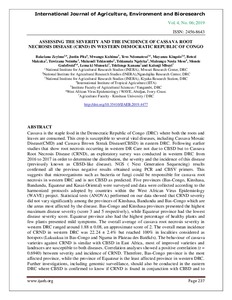| dc.contributor.author | Bakelana, Z. |
| dc.contributor.author | Pita, J. |
| dc.contributor.author | Mwangu, K. |
| dc.contributor.author | Tevo, N. |
| dc.contributor.author | Mayanza, K. |
| dc.contributor.author | Betezi, M. |
| dc.contributor.author | Tuwizana, N. |
| dc.contributor.author | Mukendi, T. |
| dc.contributor.author | Tshiamala, N. |
| dc.contributor.author | Mahungu, N. |
| dc.contributor.author | Monde, G. |
| dc.contributor.author | Lema, K.M. |
| dc.contributor.author | Kanana, T. |
| dc.contributor.author | Kalonji, M. |
| dc.date.accessioned | 2020-02-27T10:39:40Z |
| dc.date.available | 2020-02-27T10:39:40Z |
| dc.date.issued | 2019-01 |
| dc.identifier.citation | Bakelana, Z., Pita, J., Mwangu, K., Tevo, N., Mayanza, K., Betezi, M., ... & Kalonji, M. (2019). Assessing the severity and the incidence of Cassava Root Necrosis Disease (CRND) in western Democratic Republic of Congo. International Journal of Agriculture, Environment and Bioresearch. 4(6), 237-253. |
| dc.identifier.issn | 2456-8643 |
| dc.identifier.uri | https://hdl.handle.net/20.500.12478/6797 |
| dc.description.abstract | Cassava is the staple food in the Democratic Republic of Congo (DRC) where both the roots and leaves are consumed. This crop is susceptible to several viral diseases, including Cassava Mosaic Disease(CMD) and Cassava Brown Streak Disease(CBSD) in eastern DRC. Following earlier studies that show root necrosis occurring in western DR Care not due to CBSD but to Cassava Root Necrosis Disease (CRND), an exploratory survey was conducted in western DRC from 2016 to 2017 in order to determine the distribution, the severity and the incidence of this disease (previously known as CBSD-like disease). NGS ( Next Generation Sequencing) results confirmed all the previous negative results obtained using PCR and CBSV primers. This suggests that microorganisms such as bacteria or fungi could be responsible for cassava root necrosis in western DRC and is not CBSD as predicted. Five provinces (Bas-Congo, Kinshasa, Bandundu, Equateur and Kasai-Oriental) were surveyed and data were collected according to the harmonized protocols adopted by countries within the West African Virus Epidemiology (WAVE) project. Statistical tests (ANOVA) performed on our data showed that CRND severity did not vary significantly among the provinces of Kinshasa, Bandundu and Bas-Congo which are the areas most affected by the disease. Bas-Congo and Kinshasa provinces presented the highest maximum disease severity (score 3 and 5 respectively), while Equateur province had the lowest disease severity score. Equateur province also had the highest percentage of healthy plants and few plants presented mild symptoms. The overall average of cassava root necrosis severity in western DRC ranged around 1.88 ± 0.08, an approximate score of 2. The overall mean incidence of CRND in western DRC was 22.24 ± 2.4% but reached 100% in localities considered as hotspots (Lukuakua in Bas-Congo and Nguma in Plateau des Batékés). The behaviour of cassava varieties against CRND is similar with CBSD in East Africa, most of improved varieties and landraces are susceptible to both diseases. Correlation analyses showed a positive correlation (r = 0.6940) between severity and incidence of CRND. Therefore, Bas-Congo province is the most affected province, while the province of Equateur is the least affected province in western DRC. Further investigations, including genomic surveillance, should also be conducted in the eastern DRC where CBSD is confirmed to know if CRND is found in conjunction with CBSD and to report possible instances of mixed infections. For medium-term disease control, our study suggests that the development and deployment of control measures including cultivars with resistance to CRND and CBSD should be a priority. |
| dc.description.sponsorship | Bill & Melinda Gates Foundation |
| dc.description.sponsorship | West African Virus Epidemiology |
| dc.format.extent | 237-253 |
| dc.language.iso | en |
| dc.subject | Cassava |
| dc.subject | Democratic Republic of the Congo |
| dc.subject | Roots |
| dc.subject | Necrosis |
| dc.subject | Leaves |
| dc.subject | Diseases |
| dc.title | Assessing the severity and the incidence of Cassava Root Necrosis Disease (CRND) in western Democratic Republic of Congo |
| dc.type | Journal Article |
| cg.contributor.crp | Agriculture for Nutrition and Health |
| cg.contributor.crp | Roots, Tubers and Bananas |
| cg.contributor.affiliation | National Institute for Agricultural Research Studies, DR. Congo |
| cg.contributor.affiliation | International Institute of Tropical Agriculture |
| cg.contributor.affiliation | Institute Faculty of Agricultural Sciences, Yangambi |
| cg.contributor.affiliation | Kinshasa University |
| cg.coverage.region | Africa |
| cg.coverage.region | Central Africa |
| cg.coverage.country | Democratic Republic of the Congo |
| cg.coverage.hub | Central Africa Hub |
| cg.creator.identifier | Nzola Mahungu: 0000-0002-3781-0838 |
| cg.researchtheme | Biotech and Plant Breeding |
| cg.identifier.bibtexciteid | BAKELANA:2019c |
| cg.authorship.types | CGIAR and developing country institute |
| cg.iitasubject | Agronomy |
| cg.iitasubject | Cassava |
| cg.iitasubject | Disease Control |
| cg.iitasubject | Plant Breeding |
| cg.iitasubject | Plant Diseases |
| cg.iitasubject | Plant Health |
| cg.journal | Journal of Agricultural Science |
| cg.notes | Open Access Article |
| cg.accessibilitystatus | Open Access |
| cg.reviewstatus | Peer Review |
| cg.usagerightslicense | Creative Commons Attribution-ShareAlike 3.0 (CC BY-SA 3.0) |
| cg.targetaudience | Scientists |
| cg.identifier.doi | https://dx.doi.org/10.35410/IJAEB.2019.4477 |

